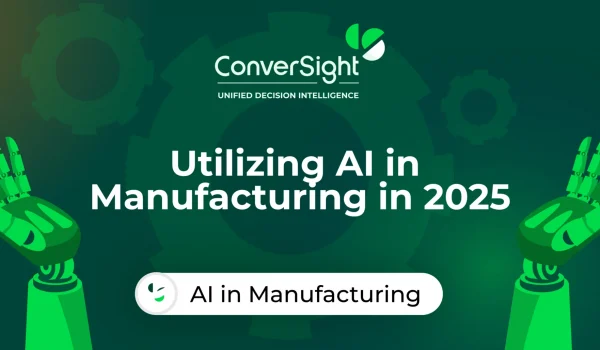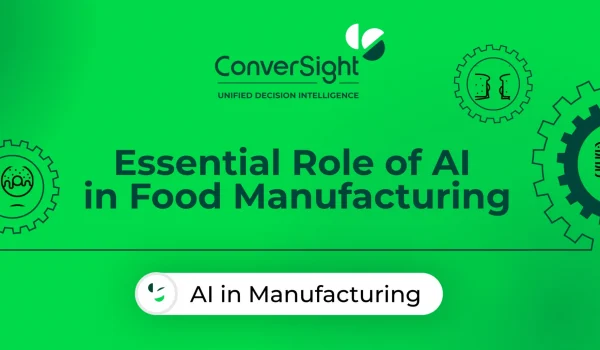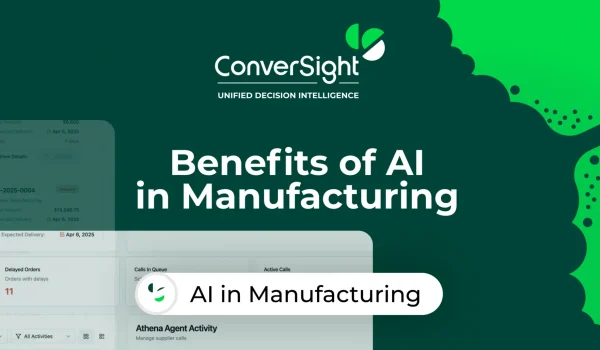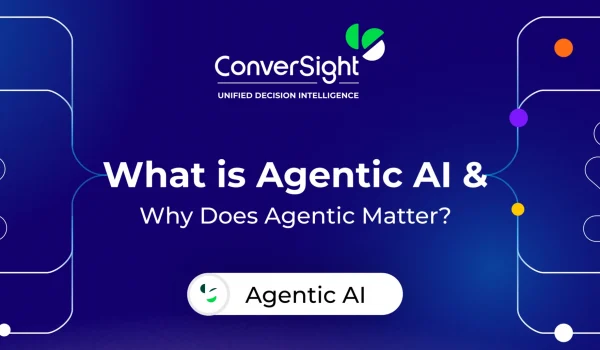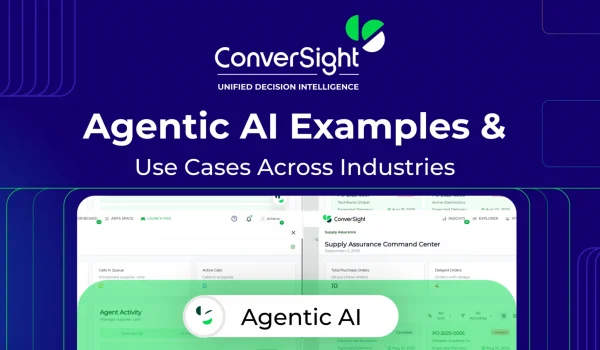Why Waiting on Data Is Costing Your Business
Enterprises today are inundated with data. Reports, dashboards, KPIs, and analytics pour in from every corner of the organization—yet critical decisions often remain slow and reactive. Many organizations find themselves in a loop of analyzing insights without timely action, causing missed opportunities and delayed responses to market shifts.
Dashboards have long been the foundation of Business Intelligence (BI), providing transparency and clarity on past performance. However, in today’s fast-moving business environment, visibility alone is insufficient. Organizations are rewarded not for knowing what occurred yesterday, but for making informed, timely decisions today that shape the outcomes of tomorrow.
Decision Intelligence (DI) addresses this execution gap. Unlike BI, which focuses on historical analysis and descriptive insights, DI equips enterprises with predictive and prescriptive capabilities. It not only highlights trends but also recommends actionable next steps, enabling leaders to act with speed and confidence.
Relying solely on traditional BI can leave organizations vulnerable. Delays in translating data into decisions result in slower operational responses, reduced competitiveness, and missed opportunities for growth or innovation. DI bridges this gap by converting raw insights into strategic actions, creating a culture of proactive decision-making.

Business Intelligence: Building the Insight Foundation
Business Intelligence (BI) serves as the cornerstone of modern enterprise decision-making. At its core, BI transforms raw data into structured insights, enabling organizations to understand past performance, identify trends, and evaluate operational efficiency.
The strengths of BI include:
- Transparent reporting and structured data visibility across all functions
- Visual dashboards that make complex datasets understandable
- Historical and trend analysis to reveal patterns over time
- Descriptive analytics to contextualize performance metrics
BI equips leaders and teams to answer questions such as: What drove performance changes last quarter? Where are operational bottlenecks? Which strategies have yielded measurable results?
However, BI alone has limitations. While it fosters awareness, it does not provide guidance for the next steps. Decision-makers often find themselves in a cycle of reviewing reports without a clear path to action. This gap can slow response times and impede strategic execution, highlighting the need for a complementary approach: Decision Intelligence (DI).
Decision Intelligence: Driving Outcomes, Not Just Insights
Decision Intelligence (DI) represents the evolution of enterprise analytics, transforming visibility into actionable strategy. Unlike traditional BI, DI integrates artificial intelligence, machine learning, and behavioural science to recommend the best course of action and predict outcomes before they occur.
Core capabilities of DI include:
- Predictive analytics: Anticipates trends, potential risks, and future scenarios
- Prescriptive recommendations: Offers the most effective courses of action
- Simulations and modelling: Tests scenarios in real-time to evaluate potential impacts
- Automation: Enables routine or high-volume decisions to be executed without delay
The value of DI lies in its ability to shrink the gap between insight and execution. Organizations no longer need to wait days or weeks to interpret dashboards; instead, DI empowers teams to respond instantly, making every decision strategic and informed.
Agility is no longer optional. For businesses in competitive markets, speed, accuracy, and confidence in decision-making are vital. DI closes the execution gap, turning analysis into measurable business outcomes.
Unlock the power of Decision Intelligence today—see how ConverSight turns insights into action.
Decision Intelligence vs Business Intelligence: A Clear Comparison
While Business Intelligence (BI) and Decision Intelligence (DI) are often discussed together, their roles in enterprise decision-making are distinct yet complementary. BI establishes situational awareness—it explains what has happened and why, giving organizations a reliable foundation of truth. DI builds on that foundation by looking ahead, prescribing actions, simulating outcomes, and in many cases, automating responses.
The real distinction lies in purpose: one creates clarity, the other drives action. Historical insight ensures decisions are grounded in facts, while forward-looking intelligence converts those insights into next steps that accelerate execution and reduce uncertainty.
Here’s how they differ across key dimensions:

Why Businesses Need Both
BI and DI are not competing technologies—they are complementary pillars of enterprise intelligence. Together, they enable organizations to convert raw data into informed actions and measurable business outcomes.
BI as the Foundation:
BI delivers structured visibility across all data sources. It ensures transparency, provides context for performance metrics, and allows organizations to answer essential questions such as: “What happened?” and “Why did it happen?” Without BI, decisions are made in the dark, relying on intuition or incomplete information.
DI as the Direction:
DI builds on the insights BI provides and guides decision-making. By leveraging predictive analytics, prescriptive recommendations, and automated actions, DI helps organizations determine the best course forward. It transforms insights into tangible results and accelerates execution across teams and departments.
The relationship can be likened to engine and fuel:
- BI is the engine, capturing, processing, and explaining data.
- DI is the fuel, propelling decisions into action and enabling organizations to respond faster to emerging opportunities or challenges.
Together, BI and DI create a closed-loop system: organizations not only understand historical performance but can anticipate future scenarios and act decisively. This integration is the foundation for moving from being merely data-driven to truly decision-driven, where every action is informed, timely, and aligned with strategic objectives.

How Industries Are Leveraging Decision Intelligence
The value of Decision Intelligence isn’t confined to one sector. It adapts to the unique challenges of different industries—and while the applications differ, the outcome is consistent: faster execution, lower risk, and smarter decisions.
Retail and eCommerce: Instead of relying solely on sales reports, retailers use DI for dynamic pricing and promotion strategies. This ensures better margins during peak demand, reduces stockouts, and enhances customer loyalty across channels.
Manufacturing: DI simulates supply and demand scenarios to optimize production planning. Manufacturers gain agility to avoid downtime, reduce carrying costs, and strengthen just-in-time operations.
Healthcare: BI provides patient history, but DI enables optimized treatment pathways and resource allocation. Hospitals and providers see improved patient outcomes, reduced emergency costs, and more efficient use of staff and equipment.
Finance: Beyond fraud pattern reports, DI predicts risks and recommends preventive actions. This strengthens compliance, reduces financial losses, and builds greater customer trust.
Supply Chain & Logistics: While BI highlights shipment delays, DI provides actionable alternatives—rerouting shipments, adjusting vendor strategies, and streamlining fulfillment. The result: resilient operations, lower last-mile expenses, and improved service levels.
How Enterprise Intelligence Is Being Redefined
Enterprise intelligence is not static—it evolves as businesses demand greater agility, faster execution, and forward-looking insights. As organizations navigate 2026, several key trends are shaping how Business Intelligence (BI) and Decision Intelligence (DI) work together to power smarter decisions:
1. Moving Beyond Dashboards
While dashboards remain foundational, their role is shifting. Enterprises no longer want to merely visualize historical data—they need tools that guide decisions in real time. Decision Intelligence moves beyond reporting the past to directing the future, enabling faster, data-backed actions that improve competitiveness.
2. Convergence of BI and DI into a Unified Ecosystem
Rather than treating BI and DI as separate layers, leading enterprises are integrating them into a cohesive decision ecosystem. BI provides structured insights, while DI adds predictive and prescriptive intelligence. This convergence enables continuous, closed-loop decision-making, ensuring that insights automatically translate into actionable outcomes.
3. GenAI and Automation as Growth Accelerators
Generative AI and automation are rapidly becoming core enablers of Decision Intelligence. From simulating market scenarios to generating prescriptive recommendations, these technologies inject speed, precision, and scalability into enterprise decision-making. Organizations leveraging AI-driven automation are moving from being data-driven to truly decision-driven.
4. Explainable AI
Modern DI solutions increasingly provide explanations for their recommendations, allowing leaders to understand the rationale behind each decision. Explainable AI fosters trust and adoption across teams, especially in high-stakes decisions, ensuring that automation and recommendations are both actionable and credible.
5. Real-Time Collaboration and Decision Workflows
Decision-making no longer happens in isolation. DI platforms now enable real-time collaboration, connecting cross-functional teams around shared insights. Integrated decision workflows reduce bottlenecks, accelerate execution, and ensure alignment across all departments, making enterprise decisions faster and more coordinated.
6. Continuous Learning and Adaptive Decision Systems
DI systems are evolving to learn continuously from outcomes, refining recommendations based on real-world results. This adaptive intelligence ensures that enterprises remain responsive to shifting market conditions, operational disruptions, and emerging opportunities, maintaining a competitive edge.
Why it matters:
The organizations that embrace these trends are building resilience, agility, and long-term competitiveness. Those that limit themselves to traditional BI risk being left behind—stuck in analysis paralysis while peers leverage DI to act decisively, collaboratively, and responsibly.
From Insights to Action: How ConverSight Bridges the Gap
For many organizations, BI dashboards create visibility but stop short of impact. Reports are generated, numbers are reviewed, yet the “action gap” remains: the disconnect between what businesses see and what they do.
ConverSight was built to solve this gap, transforming static insights into live, decision-ready intelligence. Here’s how it works:
- Ask in Natural Language
Users don’t need to learn complex systems. They can simply ask, “Why did supply chain costs spike last month?” and receive clear, contextual responses in seconds.
- Forecast Ahead
With predictive analytics, ConverSight helps enterprises anticipate risks before they appear in dashboards—whether it’s a stockout risk, a demand surge, or logistics delays.
- Get Prescriptive Guidance
Rather than just surfacing data, the platform recommends the best next action. For example: rerouting shipments, adjusting pricing, or rebalancing inventory.
- Automate Where It Counts
Routine, repeatable decisions can be automated, allowing enterprises to act instantly while freeing leaders to focus on strategy.
The Impact:
By bridging BI and DI, ConverSight shortens the distance between a question and an answer, between data and decision. Enterprises move from reactive reporting to proactive, outcome-driven execution.
Is Your Enterprise Ready for Decision Intelligence? Key Indicators
Adopting Decision Intelligence (DI) is not just about investing in new technology—it’s about knowing when your business is ready to evolve. The signs often reveal themselves through daily challenges that leaders, managers, and teams encounter. If these symptoms feel familiar, your enterprise may already be primed for DI.
1. Decision-Making Is Too Slow: Reports are available, but acting on them takes weeks or months. In today’s markets, delay equals lost opportunity. DI shortens this gap, enabling real-time responses that align with strategic objectives.
2. Reliance on Gut Instincts: Leaders often fall back on intuition when insights are unclear or incomplete. DI replaces guesswork with predictive and prescriptive intelligence, ensuring every decision is data-backed and outcome-driven.
3. Insights Without Execution: Dashboards highlight performance trends, but they rarely suggest what to do next. If your organization is “seeing” but not “acting,” it’s a clear signal that DI is needed to bridge the gap from insight to execution.
4. Struggling to Anticipate Change: Traditional BI tells you what happened—but not what’s coming. If your enterprise is caught off guard by demand shifts, supply chain disruptions, or market fluctuations, DI provides forward-looking intelligence to anticipate and adapt.
5. Missed Growth Opportunities: Opportunities exist, but they slip by because decisions are reactive rather than proactive. DI ensures organizations don’t just react—they seize opportunities faster than competitors.
Multimedia checklist: Signs Your Organization Is Ready for Decision Intelligence
Turning Decision Intelligence into Tangible Business Impact
Adopting Decision Intelligence (DI) is not simply about adding another analytics layer—it’s about changing how organizations make and act on decisions. The key is to move from viewing data to operationalizing it across teams, processes, and strategies.
The first step is cultural: leaders must embrace a mindset where decisions are data-informed, proactive, and continuous. Instead of waiting for quarterly reports or static dashboards, DI brings intelligence directly into the workflow—whether it’s adjusting supply chain logistics in real time or anticipating shifts in customer demand before they appear in sales numbers.
Next comes technology enablement. Unlike BI tools that focus on visualizing history, DI platforms like ConverSight combine AI, machine learning, and automation to make decisions actionable. Imagine being able to ask, “How will this pricing strategy impact revenue over the next six months?” and instantly seeing simulations, recommendations, and even automated execution paths. That is the shift from reporting to real business outcomes.
Finally, the true impact of DI lies in its scalability. It doesn’t just empower executives—it democratizes decision-making by giving managers, analysts, and frontline teams the ability to act confidently. From accelerating time-to-market to optimizing supply chains and mitigating risks, DI ensures that every decision—big or small—contributes to measurable growth and agility.
Enterprises that adopt this approach don’t just become more efficient; they become future-ready. They stop reacting to yesterday’s problems and start shaping tomorrow’s opportunities.
ConverSight turns complex data and supply chain challenges into Decision Intelligence that drives real business impact. Explore ConverSight


